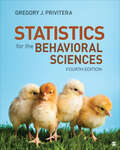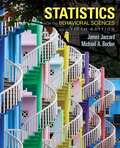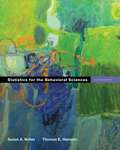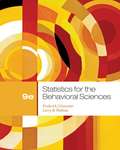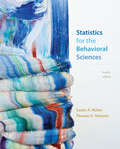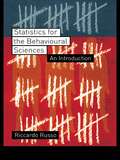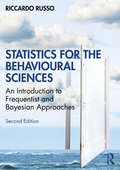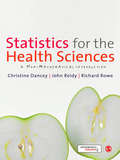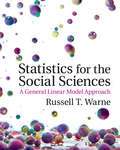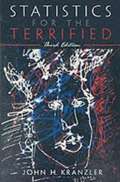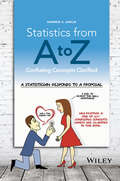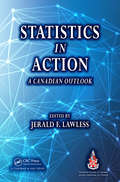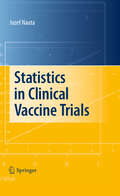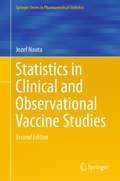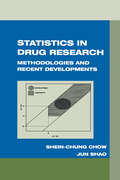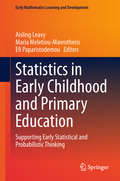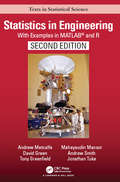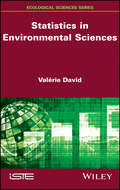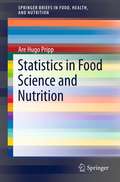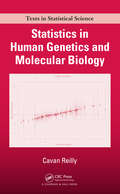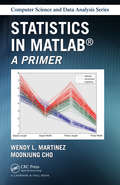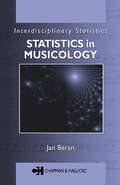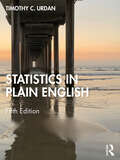- Table View
- List View
Statistics for the Behavioral Sciences
by Gregory J. PriviteraRecipient of the 2024 Textbook & Academic Authors Association (TAA) Textbook Excellence Award This award recognizes excellence in current textbooks and learning materials. Statistics for the Behavioral Sciences by award-winning author Gregory Privitera aims to not only inspire students to use statistics properly to better understand the world around them, but also to develop the skills to be lab-ready in applied research settings. Incorporating examples from current, relatable research throughout the text, Privitera shows students that statistics can be relevant, interesting, and accessible. Robust pedagogy encourages students to continually check their comprehension and hone their skills by working through problem sets throughout the text, including exercises that seamlessly integrate SPSS. This new Fourth Edition gives students a greater awareness of the best practices of analysis in the behavioral sciences, with a focus on transparency in recording, managing, analyzing, and interpreting data. Included with this title: LMS Cartridge: Import this title′s instructor resources into your school′s learning management system (LMS) and save time. Don′t use an LMS? You can still access all of the same online resources for this title via the password-protected Instructor Resource Site.
Statistics for the Behavioral Sciences
by Gregory J. PriviteraRecipient of the 2024 Textbook & Academic Authors Association (TAA) Textbook Excellence Award This award recognizes excellence in current textbooks and learning materials. Statistics for the Behavioral Sciences by award-winning author Gregory Privitera aims to not only inspire students to use statistics properly to better understand the world around them, but also to develop the skills to be lab-ready in applied research settings. Incorporating examples from current, relatable research throughout the text, Privitera shows students that statistics can be relevant, interesting, and accessible. Robust pedagogy encourages students to continually check their comprehension and hone their skills by working through problem sets throughout the text, including exercises that seamlessly integrate SPSS. This new Fourth Edition gives students a greater awareness of the best practices of analysis in the behavioral sciences, with a focus on transparency in recording, managing, analyzing, and interpreting data. Included with this title: LMS Cartridge: Import this title′s instructor resources into your school′s learning management system (LMS) and save time. Don′t use an LMS? You can still access all of the same online resources for this title via the password-protected Instructor Resource Site.
Statistics for the Behavioral Sciences
by James Jaccard Michael A. BeckerNow you can become an intelligent consumer of scientific research, without being overwhelmed by the statistics! Jaccard and Becker's book teaches readers the basic skills for analyzing data and helps them become intelligent consumers of scientific information. Praised for its real-life applications, the book tells readers when to use a particular statistic, why they should use it, and how the statistic should be computed and interpreted. Because many readers, given a set of data, cannot determine where to begin in answering relevant research questions, the authors explicate the issues involved in selecting a statistical test. Each statistical technique is introduced by giving instances where the test is most typically applied followed by an interesting research example (each example is taken from psychology literature).
Statistics for the Behavioral Sciences (2nd Edition)
by Susan A. Nolan Thomas E. HeinzenIn this new edition, author tries to connect students to statistical concepts efficiently and refocuses on the core concepts of the course and introduces each topic with a vivid example.
Statistics for the Behavioral Sciences (9th Edition)
by Larry B. Wallnau Frederick J GravetterThe author illustrates the importance of statistics in the study of behavioral science and how it provides researchers with objective and systematic methods for describing and interpreting their research results.
Statistics for the Behavioral Sciences (Fourth Edition)
by Susan A. Nolan Thomas E. HeinzenNolan and Heinzen offer an introduction to the basics of statistics that is uniquely suited for behavioral science students, with coverage anchor to real-world stories, a highly visual approach, helpful mathematical support, and step-by-step examples. The new edition focuses on emerging trends that are redefining contemporary behavioral statistics.
Statistics for the Behavioural Sciences: An Introduction
by Riccardo RussoDo you find statistics overwhelming and confusing? Have you ever wished for someone to explain the basics in a clear and easy-to-follow style? This accessible textbook gives a step-by-step introduction to all the topics covered in introductory statistics courses for the behavioural sciences, with plenty of examples discussed in depth, based on real psychology experiments utilising the statistical techniques described. Advanced sections are also provided, for those who want to learn a particular topic in more depth.Statistics for the Behavioural Sciences: An Introduction begins with an introduction to the basic concepts, before providing a detailed explanation of basic statistical tests and concepts such as descriptive statistics, probability, the binomial distribution, continuous random variables, the normal distribution, the Chi-Square distribution, the analysis of categorical data, t-tests, correlation and regression. This timely and highly readable text will be invaluable to undergraduate students of psychology, and students of research methods courses in related disciplines, as well as anyone with an interest in the basic concepts and tests associated with statistics in the behavioural sciences.
Statistics for the Behavioural Sciences: An Introduction to Frequentist and Bayesian Approaches
by Riccardo RussoThis accessible textbook is for those without a mathematical background (just some notions of basic algebra are sufficient) and provides a comprehensive introduction to all topics covered in introductory behavioural science statistics courses. It includes plenty of real examples to demonstrate approaches in depth based on real psychology experiments utilizing the statistical techniques described. New content in this thoroughly updated second edition includes an introduction to Bayesian statistics which complements the coverage of Classical/Frequentist statistics present in the first edition. It also offers practical details on how to perform analyses using JASP – a globally employed, freely downloadable statistical package. The updated eResources also feature a range of new material including additional exercises so readers can test themselves on what they have learned in the book. This timely and highly readable text will be invaluable to undergraduate students of psychology and research methods courses in related disciplines, as well as anyone with an interest in understanding and applying the basic concepts and inferential techniques associated with statistics in the behavioural sciences.
Statistics for the Health Sciences: A Non-Mathematical Introduction
by Christine Dancey Richard Rowe John ReidyStatistics for the Health Sciences is a highly readable and accessible textbook on understanding statistics for the health sciences, both conceptually and via the SPSS programme. The authors give clear explanations of the concepts underlying statistical analyses and descriptions of how these analyses are applied in health science research without complex maths formulae. The textbook takes students from the basics of research design, hypothesis testing and descriptive statistical techniques through to more advanced inferential statistical tests that health science students are likely to encounter. The strengths and weaknesses of different techniques are critically appraised throughout, and the authors emphasise how they may be used both in research and to inform best practice care in health settings. Exercises and tips throughout the book allow students to practice using SPSS. The companion website provides further practical experience of conducting statistical analyses. Features include: * multiple choice questions for both student and lecturer use * full Powerpoint slides for lecturers * practical exercises using SPSS * additional practical exercises using SAS and R This is an essential textbook for students studying beginner and intermediate level statistics across the health sciences.
Statistics for the Social Sciences
by Russell T. WarneWritten by a quantitative psychologist, this textbook explains complex statistics in accessible language to undergraduates in all branches of the social sciences. Built around the central framework of the General Linear Model (GLM), Statistics for the Social Sciences teaches students how different statistical methods are interrelated to one another. With the GLM as a basis, students with varying levels of background are better equipped to interpret statistics and learn more advanced methods in their later courses. Russell Warne makes statistics relevant to students' varying majors by using fascinating real-life examples from the social sciences. Students who use this book will benefit from clear explanations, warnings against common erroneous beliefs about statistics, and the latest developments in the philosophy, reporting and practice of statistics in the social sciences. The textbook is packed with helpful pedagogical features including learning goals, guided practice and reflection questions.
Statistics for the Terrified
by John H. KranzlerStatistics for the Terrified, 3/E, is a user-friendly introduction to elementary statistics, intended primarily for the reluctant, math anxious/avoidant person. Written in a personal and informal style, with healthy doses of humor and encouragement, the aim of the book is to help readers make the leap from apprehension to comprehension of elementary statistics. The book presents state-of-the-art, empirically supported self-help strategies (based on the cognitive behavioral techniques of rational emotive therapy) that help readers manage their math anxiety so they can relax and build confidence while still learning statistics. For those who need to learn statistics to further their career.
Statistics from A to Z: Confusing Concepts Clarified
by Andrew A. JawlikStatistics is confusing, even for smart, technically competent people. And many students and professionals find that existing books and web resources don't give them an intuitive understanding of confusing statistical concepts. That is why this book is needed. Some of the unique qualities of this book are: * Easy to Understand: Uses unique "graphics that teach" such as concept flow diagrams, compare-and-contrast tables, and even cartoons to enhance "rememberability." * Easy to Use: Alphabetically arranged, like a mini-encyclopedia, for easy lookup on the job, while studying, or during an open-book exam. * Wider Scope: Covers Statistics I and Statistics II and Six Sigma Black Belt, adding such topics as control charts and statistical process control, process capability analysis, and design of experiments. As a result, this book will be useful for business professionals and industrial engineers in addition to students and professionals in the social and physical sciences. In addition, each of the 60+ concepts is covered in one or more articles. The 75 articles in the book are usually 5-7 pages long, ensuring that things are presented in "bite-sized chunks." The first page of each article typically lists five "Keys to Understanding" which tell the reader everything they need to know on one page. This book also contains an article on "Which Statistical Tool to Use to Solve Some Common Problems", additional "Which to Use When" articles on Control Charts, Distributions, and Charts/Graphs/Plots, as well as articles explaining how different concepts work together (e.g., how Alpha, p, Critical Value, and Test Statistic interrelate). ANDREW A. JAWLIK received his B.S. in Mathematics and his M.S. in Mathematics and Computer Science from the University of Michigan. He held jobs with IBM in marketing, sales, finance, and information technology, as well as a position as Process Executive. In these jobs, he learned how to communicate difficult technical concepts in easy - to - understand terms. He completed Lean Six Sigma Black Belt coursework at the IASSC - accredited Pyzdek Institute. In order to understand the confusing statistics involved, he wrote explanations in his own words and graphics. Using this material, he passed the certification exam with a perfect score. Those statistical explanations then became the starting point for this book.
Statistics in Action, Understanding a World of Data
by Ann E. Watkins George W. Cobb Richard L. ScheafferNIMAC-sourced textbook
Statistics in Action: A Canadian Outlook
by Jerald F. LawlessCommissioned by the Statistical Society of Canada (SSC), Statistics in Action: A Canadian Outlook helps both general readers and users of statistics better appreciate the scope and importance of statistics. It presents the ways in which statistics is used while highlighting key contributions that Canadian statisticians are making to science, techno
Statistics in Clinical Vaccine Trials
by Jozef NautaThis monograph offers well-founded training and expertise on the statistical analysis of data from clinical vaccine trials, i.e., immunogenicity and vaccine field efficacy studies. The book's scope is practical rather than theoretical. It opens with two introductory chapters on the immunology of vaccines to provide readers with the necessary background knowledge. It then continues with an in-depth exploration of the statistical methodology. Many real-life examples and SAS codes are presented, making application of the methods straightforward. Topics discussed include maximum likelihood estimation for censored antibody titers, ANCOVA for antibody values, analysis of equivalence and non-inferiority immunogenicity trial data, analysis of data from vaccine field efficacy trials (including data from studies with recurrent infection data), fitting protection curves to data of challenge or field efficacy studies, and the analysis of vaccine safety data.
Statistics in Clinical and Observational Vaccine Studies (Springer Series in Pharmaceutical Statistics)
by Jozef NautaThis book offers an overview of the statistical methods used in clinical and observational vaccine studies. Pursuing a practical rather than theoretical approach, it presents a range of real-world examples with SAS codes, making the application of the methods straightforward. This revised edition has been significantly expanded to reflect the current interest in this area. It opens with two introductory chapters on the immunology of vaccines to provide readers with the necessary background knowledge. It then continues with an in-depth exploration of the analysis of immunogenicity data. Discussed are, amongst others, maximum likelihood estimation for censored antibody titers, ANCOVA for antibody values, analysis of data of equivalence, and non-inferiority immunogenicity studies. Other topics covered include fitting protection curves to data from vaccine efficacy studies, and the analysis of vaccine safety data. In addition, the book features four new chapters on vaccine field studies: an introductory one, one on randomized vaccine efficacy studies, one on observational vaccine effectiveness studies, and one on the meta-analysis of vaccine efficacy studies. The book offers useful insights for statisticians and epidemiologists working in the pharmaceutical industry or at vaccines institutes, as well as graduate students interested in pharmaceutical statistics.
Statistics in Drug Research: Methodologies and Recent Developments
by Shein-Chung Chow Jun ShaoEmphasizing the role of good statistical practices (GSP) in drug research and formulation, this book outlines important statistics applications for each stage of pharmaceutical development to ensure the valid design, analysis, and assessment of drug products under investigation and establish the safety and efficacy of pharmaceutical compounds. Cove
Statistics in Early Childhood and Primary Education: Supporting Early Statistical and Probabilistic Thinking (Early Mathematics Learning and Development)
by Aisling Leavy Maria Meletiou-Mavrotheris Efi PaparistodemouThis compilation focuses on the theory and conceptualisation of statistics and probability in the early years and the development of young children’s (ages 3-10) understanding of data and chance. It provides a comprehensive overview of cutting-edge international research on the development of young learners’ reasoning about data and chance in formal, informal, and non-formal educational contexts. The authors share insights into young children’s statistical and probabilistic reasoning and provide early childhood educators and researchers with a wealth of illustrative examples, suggestions, and practical strategies on how to address the challenges arising from the introduction of statistical and probabilistic concepts in pre-school and school curricula. This collection will inform practices in research and teaching by providing a detailed account of current best practices, challenges, and issues, and of future trends and directions in early statistical and probabilistic learning worldwide. Further, it will contribute to future research and theory building by addressing theoretical, epistemological, and methodological considerations regarding the design of probability and statistics learning environments for young children.
Statistics in Engineering: With Examples in MATLAB® and R, Second Edition (Chapman & Hall/CRC Texts in Statistical Science)
by Andrew Smith David Green Tony Greenfield Andrew Metcalfe Mayhayaudin Mansor Jonathan TukeEngineers are expected to design structures and machines that can operate in challenging and volatile environments, while allowing for variation in materials and noise in measurements and signals. Statistics in Engineering, Second Edition: With Examples in MATLAB and R covers the fundamentals of probability and statistics and explains how to use these basic techniques to estimate and model random variation in the context of engineering analysis and design in all types of environments. The first eight chapters cover probability and probability distributions, graphical displays of data and descriptive statistics, combinations of random variables and propagation of error, statistical inference, bivariate distributions and correlation, linear regression on a single predictor variable, and the measurement error model. This leads to chapters including multiple regression; comparisons of several means and split-plot designs together with analysis of variance; probability models; and sampling strategies. Distinctive features include: All examples based on work in industry, consulting to industry, and research for industry Examples and case studies include all engineering disciplines Emphasis on probabilistic modeling including decision trees, Markov chains and processes, and structure functions Intuitive explanations are followed by succinct mathematical justifications Emphasis on random number generation that is used for stochastic simulations of engineering systems, demonstration of key concepts, and implementation of bootstrap methods for inference Use of MATLAB and the open source software R, both of which have an extensive range of statistical functions for standard analyses and also enable programing of specific applications Use of multiple regression for times series models and analysis of factorial and central composite designs Inclusion of topics such as Weibull analysis of failure times and split-plot designs that are commonly used in industry but are not usually included in introductory textbooks Experiments designed to show fundamental concepts that have been tested with large classes working in small groups Website with additional materials that is regularly updated Andrew Metcalfe, David Green, Andrew Smith, and Jonathan Tuke have taught probability and statistics to students of engineering at the University of Adelaide for many years and have substantial industry experience. Their current research includes applications to water resources engineering, mining, and telecommunications. Mahayaudin Mansor worked in banking and insurance before teaching statistics and business mathematics at the Universiti Tun Abdul Razak Malaysia and is currently a researcher specializing in data analytics and quantitative research in the Health Economics and Social Policy Research Group at the Australian Centre for Precision Health, University of South Australia. Tony Greenfield, formerly Head of Process Computing and Statistics at the British Iron and Steel Research Association, is a statistical consultant. He has been awarded the Chambers Medal for outstanding services to the Royal Statistical Society; the George Box Medal by the European Network for Business and Industrial Statistics for Outstanding Contributions to Industrial Statistics; and the William G. Hunter Award by the American Society for Quality.
Statistics in Environmental Sciences
by Valerie DavidStatistical tools are indispensable for the environmental sciences. They have become an integral part of the scientific process, from the development of the sampling plan to the obtainment of results. Statistics in Environmental Sciences provides the foundation for the interpretation of quantitative data (basic vocabulary, main laws of probabilities, etc.) and the thinking behind sampling and experimental methodology. It also introduces the principles of statistical tests such as decision theory and examines the key choices in statistical tests, while keeping the established objectives in mind. The book examines the most used statistics in the field of environmental sciences. Detailed descriptions based on concrete examples are given, as well as descriptions obtained through the use of the free software R (whose usage is also presented).
Statistics in Food Science and Nutrition
by Are Hugo PrippMany statistical innovations are linked to applications in food science. For example, the student t-test (a statistical method) was developed to monitor the quality of stout at the Guinness Brewery and multivariate statistical methods are applied widely in the spectroscopic analysis of foods. Nevertheless, statistical methods are most often associated with engineering, mathematics, and the medical sciences, and are rarely thought to be driven by food science. Consequently, there is a dearth of statistical methods aimed specifically at food science, forcing researchers to utilize methods intended for other disciplines. The objective of this Brief will be to highlight the most needed and relevant statistical methods in food science and thus eliminate the need to learn about these methods from other fields. All methods and their applications will be illustrated with examples from research literature.
Statistics in Human Genetics and Molecular Biology (Chapman & Hall/CRC Texts in Statistical Science)
by Cavan ReillyFocusing on the roles of different segments of DNA, Statistics in Human Genetics and Molecular Biology provides a basic understanding of problems arising in the analysis of genetics and genomics. It presents statistical applications in genetic mapping, DNA/protein sequence alignment, and analyses of gene expression data from microarray experiments.
Statistics in MATLAB: A Primer (Chapman & Hall/CRC Computer Science & Data Analysis)
by Wendy L. Martinez MoonJung ChoThis primer provides an accessible introduction to MATLAB version 8 and its extensive functionality for statistics. Fulfilling the need for a practical user's guide, the book covers capabilities in the main MATLAB package, the Statistics Toolbox, and the student version of MATLAB, presenting examples of how MATLAB can be used to analyze data. It explains how to determine what method should be used for analysis, and includes figures, visual aids, and access to a companion website with data sets and additional examples.
Statistics in Musicology
by Jan BeranTraditionally, statistics and music are not generally associated with each other. However, ...intelligent... music software, computer digitization, and other advanced techniques and technologies have precipitated the need for standard statistical models to answer basic musicological questions. Statistics In Musicology presents an unprecedented intr
Statistics in Plain English
by Timothy C. UrdanStatistics in Plain English is a straightforward, conversational introduction to statistics that delivers exactly what its title promises. Each chapter begins with a brief overview of a statistic (or set of statistics) that describes what the statistic does and when to use it, followed by a detailed step-by-step explanation of how the statistic works and exactly what information it provides. Chapters also include an example of the statistic (or statistics) used in real-world research, "Worked Examples," "Writing It Up" sections that demonstrate how to write about each statistic, "Wrapping Up and Looking Forward" sections, and practice work problems. Thoroughly updated throughout, this edition features several key additions and changes. First, a new chapter on person-centered analyses, including cluster analysis and latent class analysis (LCA) has been added, providing an important alternative to the more commonly used variable-centered analyses (e.g., t tests, ANOVA, regression). Next, the chapter on non-parametric statistics has been enhanced with in-depth descriptions of Mann-Whitney U, Kruskal-Wallis, and Wilcoxon Signed-Rank analyses, in addition to the detailed discussion of the Chi-square statistic found in the previous edition. These nonparametric statistics are widely used when dealing with nonnormally distributed data. This edition also includes more information about the assumptions of various statistics, including a detailed explanation of the assumptions and consequences of violating the assumptions of regression, as well as more coverage of the normal distribution in statistics. Finally, the book features a multitude of real-world examples throughout to aid student understanding and provides them with a solid understanding of how several statistics techniques commonly used by researchers in the social sciences work. Statistics in Plain English is suitable for a wide range of readers, including students taking their first statistics course, professionals who want to refresh their statistical memory, and undergraduate or graduate students who need a concise companion to a more complicated text used in their class. The text works as a standalone or as a supplement and covers a range of statistical concepts from descriptive statistics to factor analysis and person-centered analyses.
